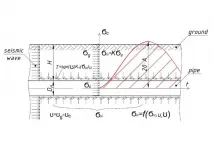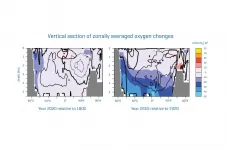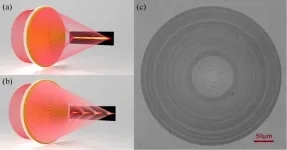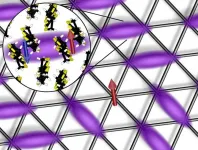Researchers develop microscopic theory of polymer gel
2021-04-16
(Press-News.org) Russian scientists have proposed a theory of phase transformation in polymer gels. It explains the mechanisms of the dramatic reduction in volume of zwitterionic hydrogels when they are cooled. The results are published in the journal Chemical Communications (ChemComm).
Polymer gels have unusual properties, including the ability to absorb water in volumes hundreds of times greater than their own. For example, some hydrogels are capable of holding up to two kilograms of water per gram of dry gel. By changing the temperature or adding solvents, various desired properties can be achieved. This is why polymer gels are used in industry and biomedicine, including for the targeted delivery of medication, creation of artificial skin, children's toys, etc.
If you take a gel containing a high volume of solvent and gradually lower its temperature, when a certain temperature threshold is reached, there will be a sharp decrease in the volume of the gel and a large amount of liquid will be squeezed out of it--the gel will collapse (contract).
The theory of gel collapse was first proposed by the American physicists and chemists Paul Flory and John Rehner, Jr. in 1943 and subsequently developed by the Japanese scientist Tsuyoshi Tanaka. A shortcoming of classical theory is that it does not take into account the peculiarities of the molecular structure of polymer links. The new theory was proposed by a team of Russian scientists consisting of Yury Budkov, Professor at MIEM HSE (HSE Tikhonov Moscow Institute of Electronics and Mathematics), Nikolai Kalikin, a PhD student at the Krestov Institute of Solution Chemistry of the Russian Academy of Sciences, and Andrei Kolesnikov, a research fellow at the Institute of Non-Classical Chemistry in Leipzig. The researchers developed a microscopic theory of polymer gel, each link of which carries an electric dipole --two electric charges equal in magnitude, but opposite in sign.
This molecular structure is most commonly found in zwitterionic polymers, whose units carry both positively and negatively charged ion groups.
The authors have shown that at sufficiently low temperatures it is the electrostatic interaction of polymer units that leads to gel collapse. They also named the main parameters influencing the transition temperature from expanded to contracted state: the dipole moment value (the product of the charge per dipole length) and the ratio of the bond length between adjacent links of the polymer chain to the dipole length.
The latter result is a significant advance in gel theory compared to the classical Flory-Rehner-Tanaka theory, which does not take into account the specific molecular structure of polymer links.
'In practice, we cannot control the molecular properties of polymer links, but thanks to our theory chemists will be able to create polymers with suitable properties in advance and control the collapse temperature,' comments Yury Budkov, professor at MIEM HSE.
The scientists note that the theoretical evaluations made will be useful in modern applications of zwitterionic gels, such as superabsorbents, molecular nanoreactors, antibacterial coatings, electrically conductive membranes for chemical current sources, artificial skin, artificial muscles and others.
Every year, the ChemComm editorial board shortlists young researchers from around the world working in different areas of chemistry and invites them to publish in a special Emerging Investigators issue. This year, Yury Budkov was among the invited young scientists in the field of Theoretical and Physical Chemistry.
INFORMATION:
ELSE PRESS RELEASES FROM THIS DATE:
2021-04-16
Two new studies published in Blood suggest that the mRNA COVID-19 vaccine may have reduced efficacy in individuals with chronic lymphocytic leukemia (CLL) and multiple myeloma, two types of blood cancer. According to researchers, these studies could help inform the ideal time for vaccination of these populations.
Study suggests two-dose COVID-19 vaccine is less effective for people with CLL as compared to healthy controls
The first study reports that people with CLL had markedly lower immune response rates to the two-dose mRNA COVID-19 vaccine than healthy individuals ...
2021-04-16
Underground pipelines that transport oil and gas are very important engineering communications worldwide. Some of these underground communications are built and operated in earthquake-prone areas.
Seismic safety or seismic stability of underground pipelines began to be intensively studied since the 1950s.
Since then, a number of methodologies were proposed for calculating stress received by an underground pipeline during an earthquake. The purpose of these methodologies was to make an accurate prediction on the structural stress received by a pipeline during an earthquake, and thus it would allow to decide ...
2021-04-16
A virtual human can be as good as a flesh-and-blood one when it comes to helping people practice new leadership skills. That's the conclusion from new research published in the journal Frontiers in Virtual Reality that evaluated the effectiveness of computer-generated characters in a training scenario compared to real human role-players in a conventional setting.
Practice-based training techniques, including role-playing, are sometimes used to help improve training outcomes. However, these methods can be expensive to implement, and often require specialized knowledge and even professional actors to create realistic training environments. In addition, some ...
2021-04-16
The preliminary trial results of a novel radiopharmaceutical for PET imaging of inflammation developed at the University of Turku, Finland, have been published. The compound, which targets the vascular adhesion protein 1 (VAP-1) that regulates inflammatory cell traffic, is the first radiopharmaceutical that has been developed completely in Finland and has advanced to clinical trials. In the study that started with healthy volunteers, the radiopharmaceutical was found to be well tolerated and safe.
The radiopharmaceutical is 68Ga-labelled Siglec-9 peptide.
"The dose of the radiopharmaceutical ...
2021-04-16
"It is machination, it is deception," said the Director General of the Berlin Royal Museums in his defence when criticized for buying a fake. Wilhelm Bode did not budge an inch: the sculpture he acquired in 1909 was an as yet unknown production of the great Renaissance master, Leonardo da Vinci. After one hundred years and numerous controversies, a group of scientists led by a CNRS researcher* has just proven him wrong once and for all. The Flora wax bust, conserved at the Bode Museum in Berlin, recently underwent radiocarbon (14C) dating, which provided both a precise date and an incontrovertible result: it was made in the nineteenth century, nearly 300 years after da Vinci's death. As the sculpture was made primarily from spermaceti, ...
2021-04-16
The life of almost all animals in the ocean depends on the availability of oxygen, which is dissolved as a gas in seawater. However, the ocean has been continuously losing oxygen for several decades. In the last 50 years, the loss of oxygen accumulates globally to about 2% of the total inventory (regionally sometimes significantly more). The main reason for this is global warming, which leads to a decrease in the solubility of gases and thus also of oxygen, as well as to a slowdown in the ocean circulation and vertical mixing. A new study published today in the scientific journal Nature Communications ...
2021-04-16
In a new publication from Opto-Electronic Advances; DOI https://doi.org/10.29026/oea.2021.200031, Researchers led by Professor Baohua Jia at Swinburne University of Technology, Victoria, Australia, Professor Cheng-Wei Qiu at National University of Singapore, Singapore and Professor Tian Lan at Beijing Institute of Technology, Beijing, China considered the generation of super-resolved optical needle and multifocal array using graphene oxide metalenses.
Ultrathin and lightweight, metalenses are becoming increasingly significant for their use in photonic chips, biosensors and micro imaging systems such as smart phone cameras.
Compared to conventional lenses, metalenses can improve the image quality of current cameras, ...
2021-04-16
In most living animals, egg cells are vastly larger than sperm cells. In humans, for example, a single egg is 10 million times the volume of a sperm cell.
In a new study, Northwestern University researchers found that competition and natural selection drove this curious size discrepancy.
Using mathematical modeling, the researchers considered a time very early in evolution when primordial species reproduced using external fertilization. In the model, bigger reproductive cells, or gametes, presented a competitive edge because they could hold more nutrients for a potential zygote. Smaller gametes, however, required fewer resources to make, which put less stress on the parent.
"Organisms either needed to produce the biggest gametes with the most provisions ...
2021-04-16
When temperatures drop below zero degrees Celsius, water turns to ice. But does everything actually freeze if you just cool it down enough? In the classical picture, matter inherently becomes solid at low temperatures. Quantum mechanics can, however, break this rule. Therefore, helium gas, for example, can become liquid at -270 degrees, but never solid under atmospheric pressure: There is no helium ice.
The same is true for the magnetic properties of materials: at sufficiently low temperatures, the magnetic moments known as 'spins', for example, arrange themselves in such a way that they are oriented opposite/antiparallel to their respective neighbors. One can think of this as arrows pointing alternating up and down along a chain or in a checkerboard pattern. It ...
2021-04-16
Snow cover in the Alps has been melting almost three days earlier per decade since the 1960s. This trend is temperature-related and cannot be compensated by heavier snowfall. By the end of the century, snow cover at 2,500 meters could disappear a month earlier than today, as simulations by environmental scientists at the University of Basel demonstrate.
Global warming demands huge adjustments in tourism, hydropower generation and agriculture in alpine areas. But the fauna and flora also have to adapt to rising temperatures. By the end of the century, ...
LAST 30 PRESS RELEASES:
[Press-News.org] Researchers develop microscopic theory of polymer gel







